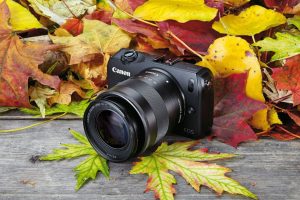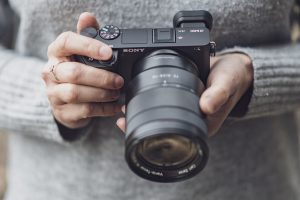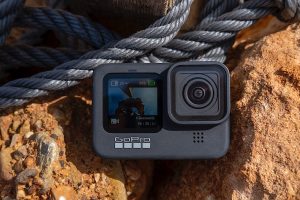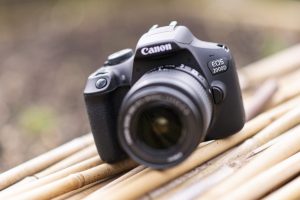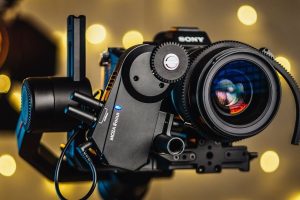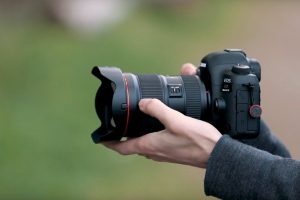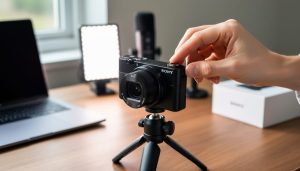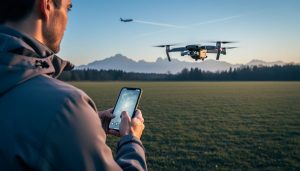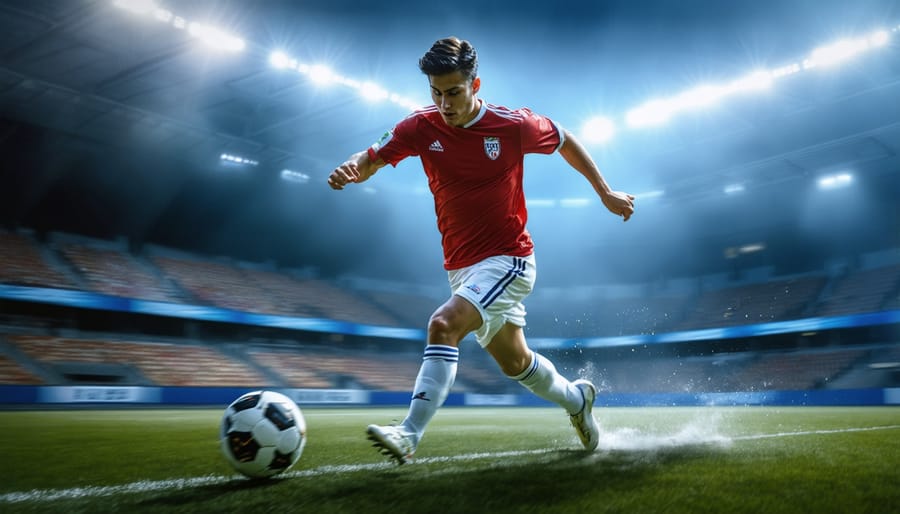
Freeze split-second athletic moments by mastering advanced action photography techniques that elevate your sports portfolio from amateur snapshots to professional masterpieces. Position yourself strategically at field level, anticipating key moments of peak action while maintaining a clear line of sight to multiple focal points. Harness the raw power of high-speed sync flash combined with fast shutter speeds (1/1000 or higher) to capture crystal-clear motion without sacrificing dramatic lighting effects. Track your subject through the viewfinder using AI-powered continuous autofocus, keeping the athlete centered while maintaining compositional balance through the rule of thirds. Dynamic sports photography demands split-second decisions, technical precision, and an artist’s eye for storytelling – transforming fleeting moments of athletic excellence into timeless visual narratives that resonate with viewers and clients alike.
The gear in your hands matters less than your ability to read the game, anticipate peak action, and execute precise timing. Whether you’re shooting from the sidelines of a professional stadium or capturing local league matches, these fundamental principles of motion, timing, and composition remain constant. Master them, and you’ll consistently deliver images that capture not just the action, but the raw emotion and intensity that make sports photography an art form unto itself.
Essential Camera Settings for Action Sports
Shutter Speed Mastery
Mastering shutter speed is crucial for capturing the perfect sports moment. When it comes to freezing fast-moving subjects, your shutter speed choices can make or break the shot. For most outdoor sports like soccer or baseball, start with 1/1000th of a second as your baseline. This speed effectively stops most athletic action while maintaining image quality.
Indoor sports present different challenges. Basketball and volleyball typically require speeds between 1/500th and 1/800th of a second, depending on your lighting conditions. For sports with extremely fast movements like tennis serves or racing cars, push your shutter speed even higher – 1/2000th or faster.
Don’t be afraid to experiment with slower shutter speeds to create artistic motion blur. Try 1/60th to 1/125th of a second while panning with your subject to keep them sharp while blurring the background. This technique works beautifully in racing sports and cycling, adding a dynamic sense of speed to your images.
Remember that available light will influence your shutter speed choices. Always balance your desire for fast speeds with your camera’s ISO capabilities and your lens’s maximum aperture to maintain optimal image quality.
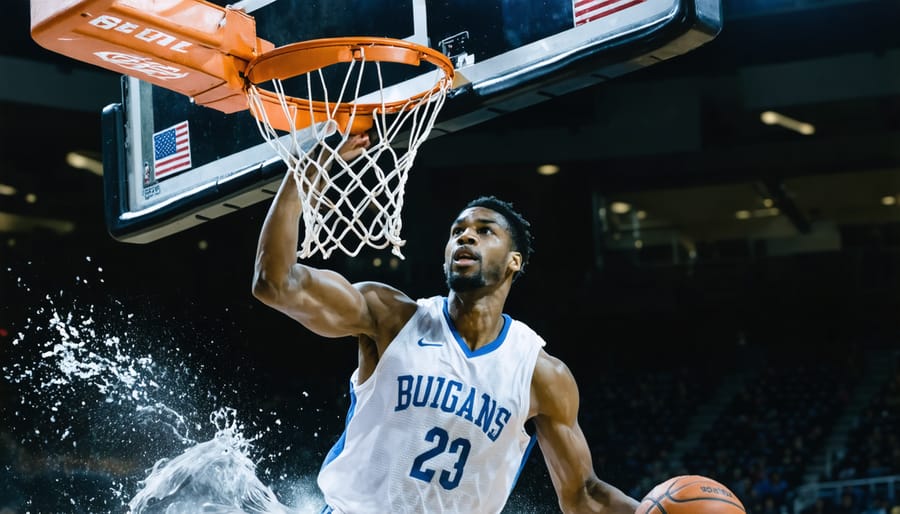
Focus Tracking Techniques
Mastering focus tracking is crucial for capturing sharp sports images. Modern cameras offer several autofocus modes, but for dynamic sports photography, continuous AF (AI Servo for Canon, AF-C for Nikon) is your best ally. This mode continuously adjusts focus as your subject moves, essential for following athletes in action.
Start by selecting multiple focus points rather than a single point – this creates a wider tracking area, making it easier to maintain focus on moving subjects. Most recent cameras feature advanced subject recognition, including eye and face detection, which can be particularly useful in sports like tennis or basketball where athletes’ faces are visible.
For optimal results, customize your camera’s tracking sensitivity. A higher sensitivity works better for erratic movements like in soccer, while lower sensitivity suits predictable movements like racing. Remember to pre-focus on areas where you anticipate the action, such as a basketball hoop or finish line.
Back-button focus is another game-changing technique, separating focus activation from your shutter button. This gives you more control and prevents the camera from hunting for focus at crucial moments.
Burst Mode Strategies
Burst mode is your secret weapon for capturing decisive moments in sports photography. Start by anticipating the action and pressing the shutter button slightly before the peak moment – whether it’s a gymnast’s dismount or a soccer player’s goal attempt. For optimal results, use burst mode selectively rather than holding it down continuously, which helps preserve battery life and saves storage space.
Most modern cameras offer different continuous shooting speeds. Choose a higher frame rate for fast-moving subjects like racing or tennis, and slower rates for more predictable actions like track events. Remember to keep your camera steady and maintain focus tracking while shooting bursts.
When shooting in burst mode, consider your memory card’s write speed to avoid buffer limitations. Using back-button focus can help maintain consistent focus while firing multiple frames, especially when tracking moving subjects across your frame.
Positioning and Anticipation
Finding the Perfect Angle
Finding the right shooting position can make or break your sports photos. In indoor venues, the sweet spot is often at court or field level, roughly 45 degrees from the primary action area. This angle provides depth while capturing both facial expressions and body movements. For basketball, position yourself near the baseline, but offset slightly to capture drives to the basket with dramatic perspective.
For outdoor sports like soccer or football, elevating your position can yield spectacular results. A higher vantage point lets you capture the full field dynamics and player formations, while incorporating creative lighting techniques with natural sunlight. When shooting track events, the curve of the track often provides the most dynamic shots, especially for sprints and relay exchanges.
Remember to scout your venue before the event. Many stadiums have specific photographer areas – knowing these restrictions beforehand helps you plan your shots. For swimming events, position yourself at the turn end of the pool for dramatic water splashes. In baseball, shooting through protective netting requires careful focus techniques, but positioning behind home plate offers unmatched perspectives of pitching dynamics.
Don’t stay static – move around when possible to vary your compositions. Some of the most compelling sports images come from unexpected angles, like ground-level shots in athletics or corner positions in combat sports.
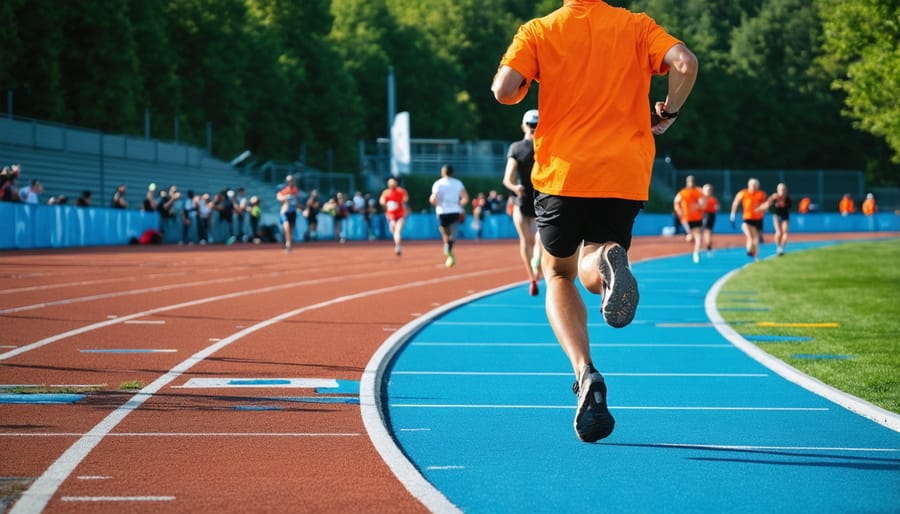
Reading the Game
Success in sports photography relies heavily on your ability to read and anticipate the game. Like a seasoned athlete, you need to understand the flow of action and predict where the next crucial moment will unfold. Start by studying the sport you’re photographing – learn its rules, common plays, and typical player movements.
Watch how athletes position themselves and observe their body language. A basketball player’s slight crouch often signals an imminent jump shot, while a soccer goalkeeper’s stance can telegraph their direction of movement. These subtle cues give you precious seconds to prepare your shot.
Position yourself strategically by identifying high-probability action zones. In football, this might mean staying near the end zone for scoring opportunities. For baseball, alternating between home plate and first base can capture both batting and base-running action. Remember that different sports have different rhythms – some offer predictable patterns, while others require quick reactions to spontaneous moments.
Pre-focus on areas where you expect action to occur, and keep both eyes open while shooting. This technique helps you maintain awareness of developing plays while capturing the current moment. During breaks in play, scan the sidelines and crowd – sometimes the most compelling shots come from player reactions or celebrations.
Learn to recognize game situations that typically lead to dramatic moments. The final minutes of a close game, set points in tennis, or penalty kicks in soccer are prime opportunities for capturing intense emotion and decisive action.
Creative Composition Techniques
Leading Lines and Movement
Leading lines and composition play a crucial role in creating stunning motion shots that draw viewers into the action. When photographing sports, look for natural lines in your environment that can enhance the sense of movement and direct attention to your subject.
Stadium lines, track markings, or even the architecture around your shooting location can serve as powerful compositional elements. For instance, when shooting track events, position yourself so the lane lines lead toward your subject. In basketball, use the court’s painted lines to create dynamic diagonal compositions that emphasize the player’s movement.
Consider the direction your subject is moving and leave space in the frame for them to “move into.” This technique, known as lead room or nose room, creates a natural flow and prevents your images from feeling cramped or static. If an athlete is running left to right, compose your shot with more space on the right side of the frame.
The rule of thirds remains valuable in sports photography, but don’t be afraid to break it intentionally. Placing your subject at the intersection points can create balance, while positioning them at the frame’s edge can heighten the sense of speed and urgency.
Remember that leading lines don’t always need to be straight. Curved paths, like a cyclist’s trajectory or a skater’s arc on ice, can create elegant compositional curves that guide viewers through your image. These S-curves add a graceful element to your sports photography while maintaining the dynamic energy of the moment.
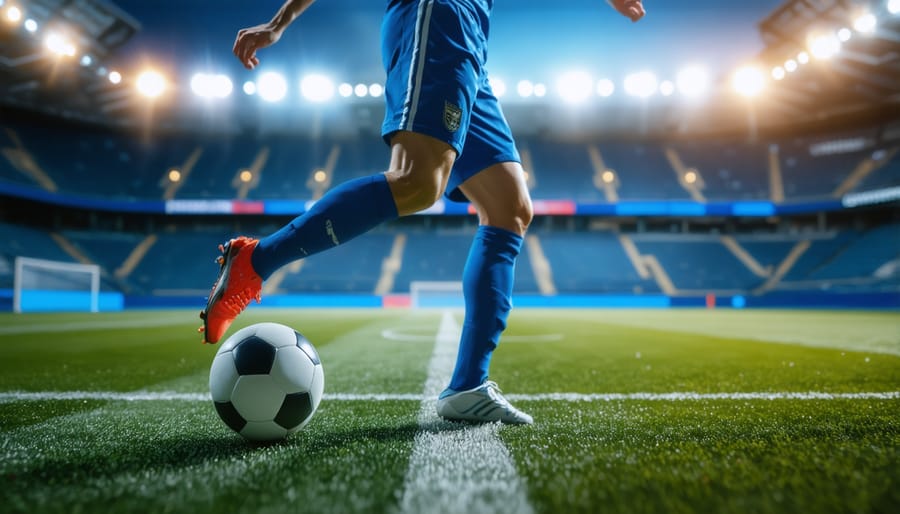
Framing the Action
The art of framing in sports photography can transform a good shot into an exceptional one. When composing your shots, consider using the rule of thirds to position your subject at power points where imaginary grid lines intersect. This creates a more dynamic and engaging composition than centering every shot.
Leave space in the direction of movement – this technique, known as “lead room” or “nose room,” gives your subject somewhere to move into the frame. For example, if a basketball player is driving to the left, compose your shot with more space on the left side of the frame to create a sense of motion and direction.
Environmental framing can add depth and context to your sports photos. Use stadium architecture, goal posts, or even other players to create natural frames around your subject. When photographing indoor sports, look for opportunities to use crowd elements or venue features to add layers to your composition.
Consider varying your shooting angle to create more dramatic frames. Get low to make athletes appear more powerful and dominant, or shoot from an elevated position to capture unique patterns and formations in team sports. Don’t be afraid to tilt your camera slightly for diagonal compositions, especially in high-energy moments like a tennis serve or a soccer kick.
Remember that negative space can be just as important as your subject. Sometimes, leaving empty space in your frame can emphasize the isolation of an athlete or create a sense of scale. This works particularly well in sports like swimming or skiing, where the environment plays a crucial role in the story.
Essential Gear Selection
Lens Selection Guide
Selecting the right lens for sports photography can make the difference between capturing or missing that decisive moment. For most sports scenarios, a telephoto zoom lens in the 70-200mm range serves as an excellent starting point, offering versatility and reach while maintaining excellent image quality.
Indoor sports like basketball or volleyball typically demand fast lenses with wide apertures (f/2.8 or faster) to compensate for lower light conditions. When combined with optimal camera settings, these lenses allow you to maintain fast shutter speeds while keeping ISO levels manageable.
For outdoor sports like soccer or baseball, consider longer focal lengths between 300-400mm to get close to the action from the sidelines. Wildlife photographers often prefer even longer focal lengths, sometimes using 600mm or longer lenses with teleconverters for additional reach.
Don’t overlook wider options, particularly for sports like skateboarding or BMX where you’ll want to capture both the athlete and their environment. A 24-70mm zoom lens works wonderfully for these scenarios, allowing you to showcase the context while maintaining the ability to zoom in for tighter compositions.
Remember that image stabilization becomes increasingly important as focal length increases. While not crucial for very fast shutter speeds, it can help tremendously when shooting in challenging light conditions or when trying to track fast-moving subjects.
Support Equipment
Supporting equipment plays a crucial role in capturing dynamic sports moments with precision and stability. A monopod is often the preferred choice for sports photographers, offering an excellent balance between mobility and stability. Unlike tripods, monopods allow quick repositioning while still providing vertical support, making them ideal for following fast-moving subjects.
Gimbals have become increasingly popular, especially for videography and hybrid shooters. These electronic stabilization devices help maintain smooth movement when tracking athletes, particularly useful for following runners, cyclists, or skaters along their path. Modern gimbals can support various camera sizes and often include intelligent tracking features.
Other essential accessories include quick-release plates for rapid equipment changes, lens support brackets for heavy telephoto lenses, and weather-protective gear. A comfortable camera strap system is vital during long events, with many photographers preferring cross-body slings or dual-camera harnesses to distribute weight evenly.
Battery grips serve dual purposes: extended shooting time and improved ergonomics when shooting in portrait orientation. Memory card wallets, lens cleaning kits, and rain covers should always be in your kit. For indoor sports, flash brackets and remote triggers can help achieve better lighting while maintaining mobility.
Consider investing in a sturdy rolling bag or backpack designed for sports photography, allowing quick access to equipment while protecting it from impacts and weather conditions.
Post-Processing for Impact
Enhancing Motion
Post-processing plays a crucial role in emphasizing the dynamic nature of sports photography. Start by adjusting motion blur selectively using radial or path blur filters to create a sense of speed around your subject while keeping them sharp. This technique works particularly well with racing sports or fast-moving athletes.
For dramatic effect, try using motion trails by duplicating your subject layer and applying a motion blur, then reducing the opacity to create a ghosting effect that suggests movement. This works especially well with images of swimmers, cyclists, or runners.
Color can also enhance the perception of motion. Increase vibrance in areas of movement while slightly desaturating the background to draw attention to the action. Consider using selective sharpening on key areas of your subject while leaving motion-affected areas slightly softer to reinforce the sense of movement.
Another powerful technique is to use curves adjustments to enhance contrast in areas of motion. This can help define the separation between your subject and any motion blur, making the overall effect more convincing. For sports involving water or powder (like skiing or surfing), emphasize these elements by adjusting highlights and clarity to make them more prominent.
Remember to work non-destructively by using adjustment layers and masks. This allows you to fine-tune your enhancements until you achieve the perfect balance between showing motion while maintaining the impact of the crucial moment.
Color and Contrast
Color and contrast play pivotal roles in making your sports action shots truly stand out. While capturing the perfect moment is crucial, the way you handle color and contrast can transform a good shot into an exceptional one. Start by shooting in RAW format to give yourself maximum flexibility in post-processing.
In high-contrast situations, like afternoon games with harsh shadows, consider using HDR techniques to balance exposure across your frame. However, be careful not to overdo it – sports photography should maintain a natural, authentic feel. Pay special attention to your white balance settings, particularly in mixed lighting conditions common in indoor sports venues.
During post-processing, selective color adjustments can help draw attention to your subject. For instance, slightly boosting the saturation of team uniforms while maintaining natural skin tones can create visual impact without looking artificial. Clarity and contrast adjustments should be approached with precision – increase local contrast around your subject to make them pop, but avoid pushing the overall contrast too far, which can create an unrealistic look.
For dramatic effect, consider converting select images to black and white, especially when dealing with challenging lighting conditions or when you want to emphasize form and motion. The absence of color can often heighten the emotional impact of an athletic moment, letting viewers focus on the raw intensity of the action.
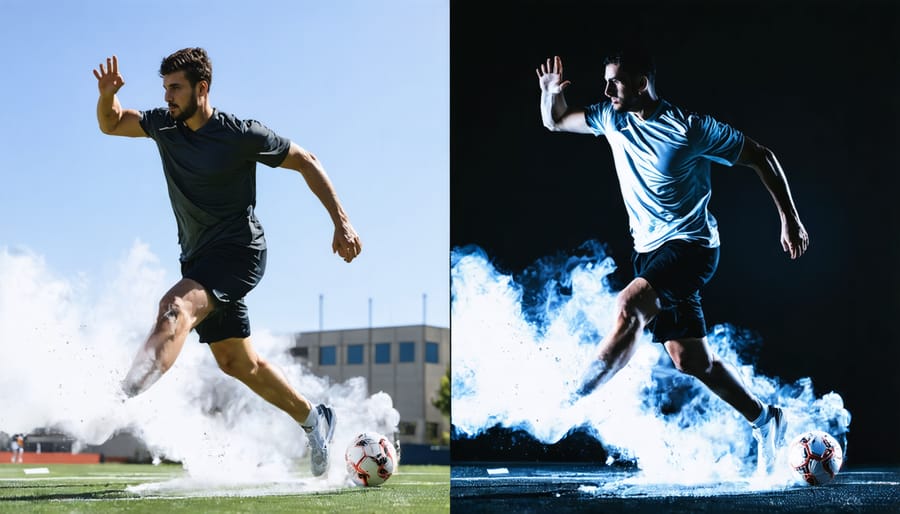
Dynamic sports photography is a thrilling and rewarding genre that demands both technical expertise and creative vision. Throughout this guide, we’ve explored the essential elements that come together to create compelling action shots, from mastering your camera settings to positioning yourself for the perfect moment. Remember that successful sports photography isn’t just about freezing motion – it’s about telling a story through your images and capturing the emotion, determination, and spirit of athletic competition.
The key to improvement lies in consistent practice and experimentation. Start with local sports events, practice sessions, or even casual games to hone your skills. Don’t be afraid to try different techniques, angles, and compositions. Review your images critically, learn from both successes and mistakes, and gradually build your portfolio.
Keep in mind that every sport presents unique challenges and opportunities. What works for basketball might need adjustment for soccer or swimming. Stay patient, remain persistent, and most importantly, enjoy the process. With time and dedication, you’ll develop an instinct for anticipating decisive moments and capturing the dynamic energy that makes sports photography so captivating.






